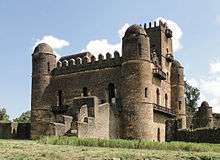Fasilides
| Fasilides | |
|---|---|
| Emperor of Ethiopia | |
 | |
| Reign | 1632 – 18 October 1667 |
| Predecessor | Susenyos I |
| Successor | Yohannes I |
| Born |
20 November 1603 Magazaz |
| Died | 18 October 1667 |
| House | House of Solomon |
| Father | Susenyos I |
| Mother | Sultana Mogassa |
| Religion | Ethiopian Orthodox Tewahedo |
Fasilides (Ge'ez ፋሲልደስ Fāsīladas, modern Fāsīledes; 20 November 1603 – 18 October 1667), also known as Fasil[1] or Basilide,[2] was emperor of Ethiopia from 1632 to 18 October 1667, and a member of the Solomonic dynasty. His throne name was ʿAlam Sagad (Ge'ez ዓለም ሰገድ ʿĀlam Sagad, modern ʿĀlem Seged), meaning "to whom the world bows". He was the son of Emperor Susenyos I and Empress Sultana Mogassa, born at Magazaz in Shewa before 10 November 1603. His paternal grandfather's name was also Fasilides.
Fasilides was proclaimed emperor in 1630 during a revolt led by Sarsa Krestos, but did not reach the throne until his father abdicated in 1632. Once he became emperor, Fasilides immediately restored the official status of the traditional Ethiopian Orthodox Church. He sent for a new abuna from the Patriarch of Alexandria, restoring the ancient relationship that had been allowed to lapse. He confiscated the lands of the Jesuits at Dankaz and elsewhere in the empire, relegating them to Fremona. When he heard that the Portuguese bombarded Mombasa, Fasilides assumed that Afonso Mendes, the Roman Catholic prelate, was behind the act, and banished the remaining Jesuits from his lands. Mendes and most of his followers made their way back to Goa, being robbed or imprisoned several times on the way. In 1665, he ordered the "Books of the Franks"—the remaining religious writings of the Catholics—burnt.
He is commonly credited with founding the city of Gondar in 1636, establishing it as Ethiopia's capital.[3] Whether or not a community existed here before he made it his capital is unknown. Amongst the buildings he had constructed there are the beginnings of the complex later known as Fasil Ghebbi, as well as some of the earliest of Gondar's fabled 44 churches: Adababay Iyasus, Adababay Tekle Haymanot, Atatami Mikael, Gemjabet Mariyam, Fit Mikael, and Qeddus Abbo.[4] He is also credited with building seven stone bridges in Ethiopia; as a result all old bridges in Ethiopia are often commonly believed to be his work.[5]
_on_Blue_Nile_River.jpg)
Emperor Fasilides also built the Cathedral Church of St Mary of Zion at Axum. Fasilides' church is known today as the "Old Cathedral" and stands next to a newer cathedral built by Emperor Haile Selassie.
The rebellion of the Agaw in Lasta, which had begun under his father, continued into his reign and for the rest of his reign he made regular punitive expeditions into Lasta. The first, in 1637, went badly, for at the Battle of Libo his men panicked before the Agaw assault and their leader, Melka Kristos, entered Fasilides' palace and took the throne for himself. Fasilides quickly recovered and sent for help to Qegnazmach Dimmo, governor of Semien, and his brother Gelawdewos, governor of Begemder. These marched on Melka Kristos, who was still at Libo, where he was killed and his men defeated. The next year Fasilides marched into Lasta; according to James Bruce, the Agaw retreated to their mountain strongholds, and "almost the whole army perished amidst the mountains; great part from famine, but a greater still from cold, a very remarkable circumstance in these latitudes."[6]
Fasilides dispatched an embassy to India in 1664–5 to congratulate Aurangzeb upon his accession to the throne of the Mughal Empire.
In 1666, after his son Dawit rebelled, Fasilides had him incarcerated at Wehni, reviving the ancient practice of confining troublesome members of the Imperial family to a mountaintop, as they had once been confined at Amba Geshen.
Fasilides died at Azazo, 8 kilometres (5 miles) south of Gondar, and his body was interred at St. Stephen's, a monastery on Daga Island in Lake Tana. When Nathaniel T. Kenney was shown Fasilides' remains, he saw a smaller mummy also shared the coffin. A monk told Kenney that it was Fasilides' seven-year-old son Isur, who had been smothered in a crush of people who had come to pay the new king homage.[7]
References
- ↑ Woredekal, Solomon (1985). "Restoration of historical monuments of Gondar". Annales d'Éthiopie. 13: 119. Retrieved 12 July 2014.
- ↑ Wion, Anaïs (2012). "Fasiladas". Dictionary of African Biography. 2. OUP. pp. 353–54.
- ↑ See the discussion in Solomon Getamun, History of the City of Gondar (Africa World Press, 2005), pp.1-4
- ↑ Getamun, City of Gondar, p. 5
- ↑ There are many lists of these seven bridges; an example can be found in Richard Pankhurst, Economic History of Ethiopia (Addis Ababa: Haile Selassie University Press, 1968), pp. 297f
- ↑ James Bruce, Travels to Discover the Source of the Nile (1805 edition), vol. 3, pp. 435-437
- ↑ Nathaniel T. Kenney, "Ethiopian Adventure", National Geographic, 127 (1965), p.557.
| Wikimedia Commons has media related to Fasilides of Ethiopia. |
| Preceded by Susenyos I |
Emperor of Ethiopia 1632–1667 |
Succeeded by Yohannes I |